Section 2: What's in a Brine?FAQ's about Salt, Sugar & Nitrite LevelsNote: This section packs a lot of info and is intended for people who want to know how a brine is formulated.
If you'd rather just follow a recipe, then feel free to move on to Section 3 where I give a basic brine recipe.So, what's in a brine? A typical curing brine contains:
Water, Salt, Sugar, Nitrite Cure, & sometimes
Other Flavorings.The three important factors are:
- Brine Strength
- Sugar Level
- Nitrite Level
Once you understand these, you'll be able to customize your own brine recipes that are safe and taste the way YOU want!
► Salt Sense - Which kind of Salt should I use?- Non-iodized table Salt & Sea Salt: Not ideal! Contains anti-caking agents and/or impurities.
- Kosher Salt: Good choice - Pure & clean tasting with no additives. Varies in size, so it should be weighed and not measured.
- Pickling salt: Best choice! - Inexpensive, made for brining, measures/weighs consistently, AND...
...it's a Kosher product - NO impurities!
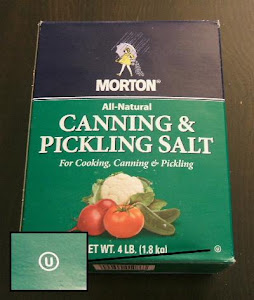
► Brine Strength (Salinity) - How Much Salt should I use?Brine strength is determined, for the most part, by how salty you like your ham.
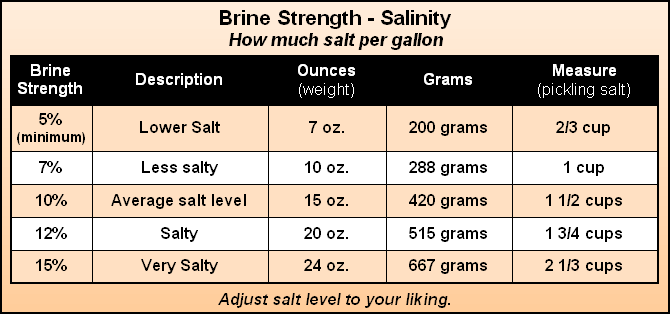 How accurate do I need to be?
How accurate do I need to be?Weighing is more accurate, but if you use pickling salt and measure according to the chart above, then you will be fine! A little more or less salt in the brine won't make a noticeable difference in your ham.
► Sugar Level (Sweetness)Sugar cuts the harshness of salt & adds favor. It doesn't affect curing, so how much you use is purely a matter of taste & the type of ham being made. Any natural, water soluble sweetener will work:
- Granulated Sugar - provides a non-descript sweetness.
- Brown Sugar - Probably my overall favorite. It's cheap with a nice hint of molasses. The darker it is - the more molasses it contains.
- Honey Self explanatory!
- Maple Syrup Definitely not cheap! If you love Maple (like I do), then consider using regular Sugar + Maple Flavoring.
Sweeteners can vary quite a bit by weight, but FORTUNATELY most of them have similar sweetness levels when measured. The one exception is Powdered Dextrose, which is only 70% as sweet as regular sugar.
Basic guide to sweetness level & weight to measure conversion:
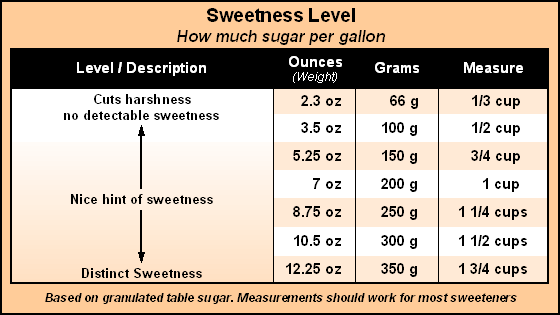
► Nitrite Curing SaltNitrite's role in curing is important. Besides preventing botulism, it helps develop the color and flavor we desire, and keeps fat from turning rancid.
Which curing salt should I use?Cure #1 is the best choice for our purpose.
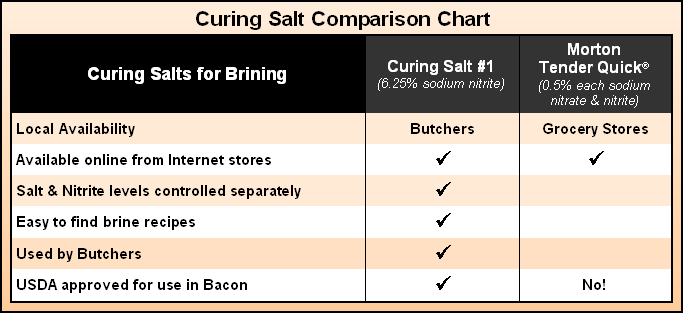 Note: Cure #1 & Tender Quick are NOT interchangeable; Do NOT use Tender Quick in recipes calling for Cure #1!Common Brands of Cure #1:
Note: Cure #1 & Tender Quick are NOT interchangeable; Do NOT use Tender Quick in recipes calling for Cure #1!Common Brands of Cure #1: Prague Powder #1, DQ Cure #1, Insta Cure #1.
The brand is not important, so long as it contains 6.25% sodium Nitrite.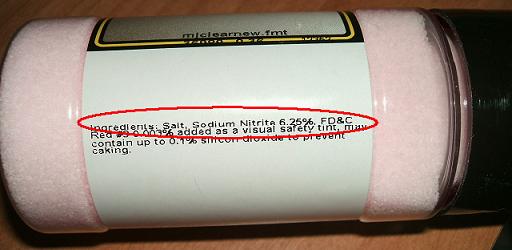
Curing salt is typically pink in color, so it's not confused it with regular salt.
► Nitrite Levels - How much Cure #1 should I use?USDA policy requires between
120 - 200 Parts Per Million of "ingoing nitrite" for
brine-cured meat.
USDA Processing Inspectors Handbook, Pg 12So,
120 PPM is our goal, but how do we achieve that?
► First off, the popular
"1 tsp per 5 lbs meat" rule CANNOT be used for brining!!!
► The
Pump Rate (how much you inject, per lb of meat) determines how much nitrite you need per gallon.
- Pick your pump rate based on how long you want the ham to cure in the brine: 10% 6-10 days; 20% 4-7 days; 30% (max) 3-5 days (I prefer a 20% or 30% pump rate).
- The more brine you inject, the less nitrite you need per gallon, because you're pumping more into the ham.
- Example: a 10% pump (10% of the ham's weight) is easy to inject, but a 20% pump uses 50% less nitrite in the brine, because you're injecting twice as much.
► So, we need to calculate based on the Pump Rate...
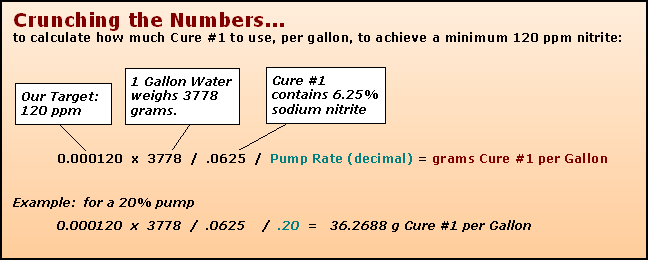
and based on that calculation we get:
 Q: Does injecting more brine affect salt & sugar levels too?
Q: Does injecting more brine affect salt & sugar levels too?
A: Not really... The nitrite get's locked in, but given at least a few days, the higher salt & sugar levels in the ham will push their way out until they equalize with the rest of the brine.
► Other FlavoringsBesides sweeteners, you may want to add other flavors to your Ham. Some common flavor ingredients:
- Pickling Spice - used for corning beef and works well with Hams too.
- Allspice Berries - Gives a classic Holiday Ham flavor of cinnamon, clove, & nutmeg.
- Juniper Berries, Coriander seeds, Peppercorns - German style Ham & Bacon
►Customizing RecipesThe tables above will make it easy to customize recipes to suit your needs.
Examples:
► If a recipe is too salty or sweet for your tastes, use the
"Brine Strength" or
"Sweetness Level" charts to adjust the levels to your liking.
► If you like a recipe, but want to inject at a 30% rate instead of 10% - in that case you would leave salt & sugar levels alone and adjust ONLY the amount of Cure #1, according to the
"Cure #1 per Gallon" table.
► To build a recipe from Scratch:
1) Pick your Salt level,
2) Pick your Sugar level & Sweetener,
3) Pick your pump rate (10% or 30%) & add the appropriate amount of Cure #1,
4) Add other flavorings as you like,
...and CONGRATULATIONS! You have just customized your own ham brine!